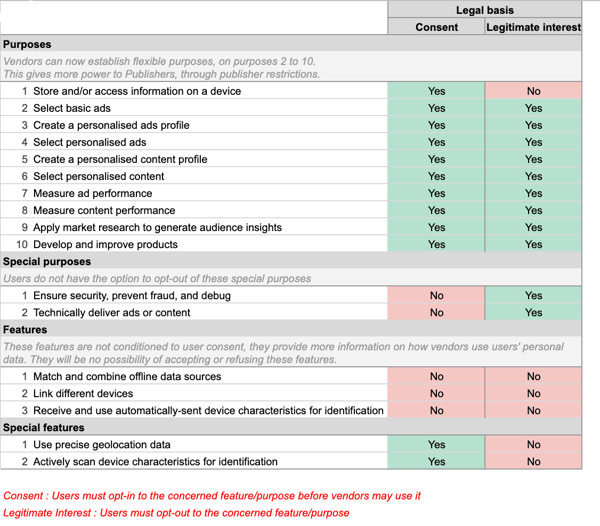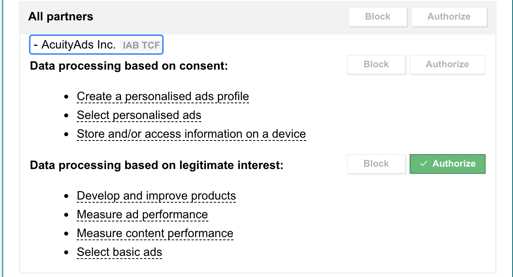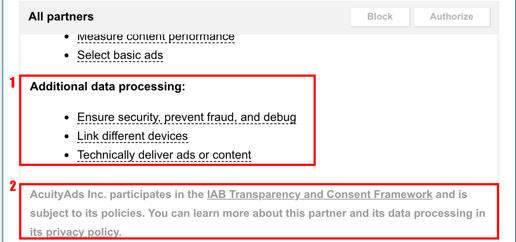This article is outdated, as starting from November 2023, the TCF version is 2.2.
Consent: users must opt-in to the concerned feature/purpose before vendors may use it.
Legitimate Interest: users must opt-out to the concerned feature/purpose.
1- Purposes
Vendors can now establish flexible purposes, on purposes 2 to 10.
This gives more power to Publishers, through publisher restrictions.
- Purpose 1 - Store and/or access information on a device
Legal basis: consent - Purpose 2 - Select basic ads
Legal basis: consent /legitimate Interests - Purpose 3 - Create a personalized ads profile
Legal basis: consent /legitimate Interests - Purpose 4 - Select personalized ads
Legal basis: consent/legitimate Interests - Purpose 5 - Create a personalized content profile
Legal basis: consent /legitimate Interests - Purpose 6 - Select personalized content
Legal basis: consent /legitimate Interests - Purpose 7 - Measure ad performance
Legal basis: consent /legitimate Interests - Purpose 8 - Measure content performance
Legal basis: consent/legitimate Interests - Purpose 9 - Apply market research to generate audience insights
Legal basis: consent/legitimate Interests - Purpose 10 - Develop and improve products
Legal basis: consent/legitimate Interests
2- Special purposes
- Users do not have the option to opt-out of these special purposes:
Special Purpose 1 - Ensure security, prevent fraud, and debug
Legal basis : Legitimate Interests - Special Purpose 2 - Technically deliver ads or content
Legal basis : Legitimate Interests
3- Features
These features are not conditioned to user consent, they provide more information on how vendors use users' personal data. They will be no possibility of accepting or refusing these features.
- Feature 1 - Match and combine offline data sources
- Feature 2 - Link different devices
- Feature 3 - Receive and use automatically-sent device characteristics for identification
4- Special features
Special Feature 1 - Use precise geolocation data
Legal basis : Consent
Special Feature 2 - Actively scan device characteristics for identification
Legal bases : Consent
Special features and purposes can be managed in stacks that will regroup them by categories.
In a nutshell here is a document that can help you see which are the legal bases used :

5- This how they should appear in your consent notice:
- First view (notice view) :
- The complete list of purposes or the stacks (1) + purpose number 1. (2)
- Special features or stack 1 (including both special features). (3)
- "Personalised ads and content" (1)
- Ad and content measurement (1)
- Audience insights and product development (1)
- Store and/or access information on a device (2)
- Precise geolocalisation data (3)
- Identification through device scanning (3)

- Second view (preference view):
- All purposes and/or stacks. (1)
- Special features. (2)
- Special purposes. (3)
- Features. (4)
- Third view (vendor's view):
- List of legal basis that are linked to purposes used by every partner. (first image)
- List of additional data processing. (1) (special purposes & features)
- A link redirecting to the privacy policy of the concerned vendor. (2)


🎤 Feel free to check out our webinar about second version of the TCF (TCFv2) moderated by Jawad Stouli (Co-founder and CTO of Didomi), available on Youtube!